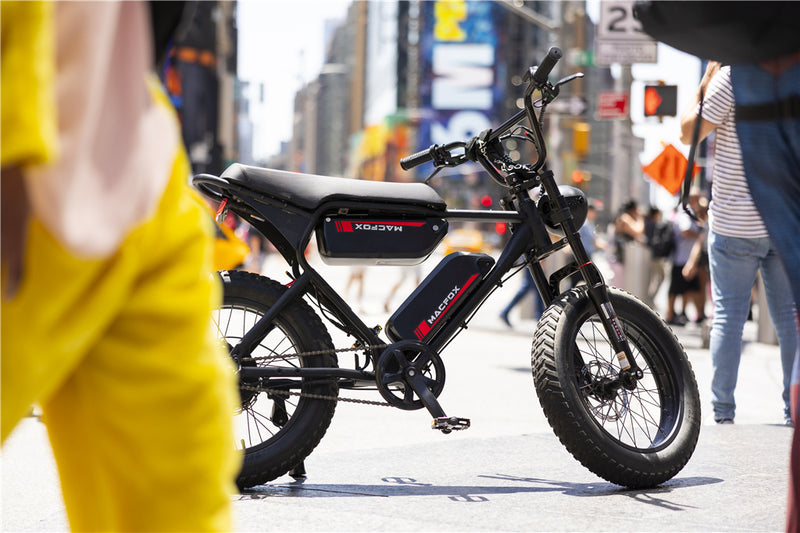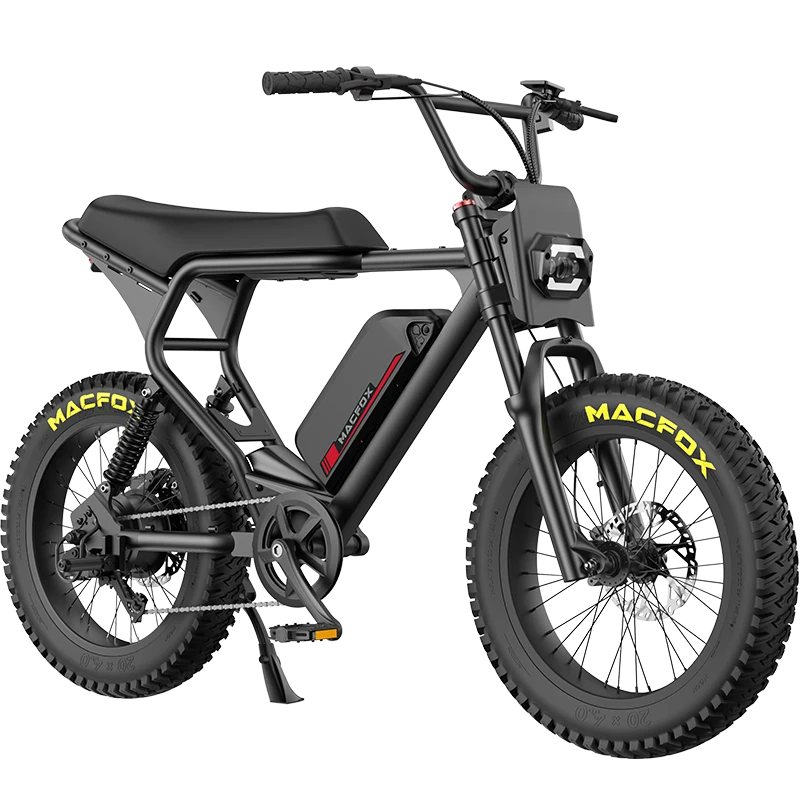Electric bikes have quickly become a popular way to get around because they are both environmentally friendly and extremely convenient.
But to really get the best out of your e-bike, it’s important to understand how much power it uses. Knowing this will help you get the most out of your battery, make your bike last longer, and keep your costs in check.
This guide will walk you through the key things that affect how much power your e-bike uses, breaking everything down into simple, easy-to-grasp sections.
Understanding Watts and Why They Matter

When it comes to e-bikes, the term "watts" is thrown around a lot. But what does it actually mean?
Watts are a way to measure how much energy your e-bike’s motor uses. This number directly affects how your bike performs. But why is this so important?
Let’s break it down.
What Watts Do for Your E-Bike
When you’re talking about e-bikes, you’ll often hear about the "wattage" of the motor. But what does this mean for your ride?
Watts (W) tell you how much power your e-bike’s motor is using. The higher the wattage, the more powerful the motor. This means your bike can go faster, pick up speed quicker, and handle hills better.
For example, an e-bike with a 250W motor is great for flat roads and lighter riders. It has enough power for city commuting and casual rides. However, it might struggle when going up steep hills or carrying heavier loads.
On the other hand, a 500W motor gives you more power. It’s better at getting you up to speed and handling hilly terrain. This makes it a good option if you need a bit more power for longer or more demanding rides.
Finally, e-bikes with motors rated at 750W or more are for those who really need some serious power. These bikes can tackle steep hills and heavier loads but use more energy, which can shorten the distance you can ride before needing to recharge.
Why Watts Aren't the Only Thing That Matters
While wattage is important, it’s not the only thing that determines how well your e-bike performs.
The type of motor also matters a lot. For example, a 250W mid-drive motor (which sits in the middle of the bike) might actually do better on hills than a 500W hub motor (which is in the wheel).
Mid-drive motors use the bike’s gears to help you climb hills without using as much power. Plus, other things like how much you weigh, the kind of roads you ride on, and how much you pedal also affect how much power you need.
Read more: Electric Bike – Mid-Engine or Rear-Engine?
Voltage and How It Affects Your E-Bike
Voltage is another big factor that affects how your e-bike works.
While watts measure the motor’s power, voltage refers to how much electrical "push" the battery has. This "push" helps determine how much power the motor can actually use, which affects your overall ride.
So how does voltage affect your ride, and what should you think about when picking a battery?
How Voltage Impacts Power
Voltage helps determine how much power your e-bike’s motor can draw from the battery.
Higher voltage usually means more power, which can help with speed, acceleration, and getting up hills.
Most e-bikes come with 36V, 48V, or 52V batteries. Each one offers different levels of performance, suited to different kinds of riding.
For example, 36V batteries are often found on older or more basic e-bikes. These are fine for flat roads and casual rides but might struggle with steep hills or heavy loads.
A 48V battery, which is more common on modern e-bikes, offers a nice balance between power, efficiency, and range. It’s a great choice if you need reliable performance across different types of terrain.
If you’re looking for even more power, a 52V battery gives you more speed and better hill-climbing ability. However, these batteries are heavier and more expensive, so they’re best for riders who often face tough riding conditions and need that extra boost.
The Trade-Off Between Voltage and Battery Life
While higher voltage batteries give you more power, they also use up energy faster, meaning the battery might not last as long on a single charge compared to lower voltage batteries.
Understanding this trade-off is important when picking the right battery for your e-bike. You need to think about how much power you need, how long your rides usually are, and whether the benefits of a higher voltage battery outweigh the fact that it might run out of juice faster.
Figuring Out How Much Power Your E-Bike Uses
Knowing how much power your e-bike uses is key to getting the most out of your battery and planning your rides. By figuring out your e-bike’s power usage, you can better manage your battery life and make sure you’re not left stranded with a dead battery.
But how do you figure out how much power your e-bike is using, and what should you keep in mind?
How to Calculate Power Usage
Calculating how much power your e-bike uses involves understanding the relationship between the battery’s voltage and the motor’s power draw.
To figure out the power usage, you can use this simple formula:
Power (Watts) = Battery Voltage (V) × Peak Current (A)
For example, if your e-bike has a 48V battery and a controller with a peak current of 15A, the power output would be:
48V × 15A = 720W
This number tells you how much power your e-bike is using at any given moment.
However, the actual power usage can vary depending on things like how fast you’re going, the kind of terrain you’re on, and how much you’re pedaling.
Real-World Power Usage
In the real world, how much power your e-bike uses can change a lot depending on where and how you’re riding.
For instance, if you’re riding on flat ground at a steady pace, you might only need 200W to 300W of power. This means your battery will last longer, letting you ride further on a single charge.
But if you’re going up a steep hill, your motor might need to use 750W or more, which will drain your battery faster and shorten your ride.
Also, how much you pedal can make a big difference. The more you pedal, the less power your motor needs to use, which can help your battery last longer and increase your range.
The Cost of Charging Your E-Bike
One of the great things about e-bikes is that they’re pretty cheap to charge compared to other forms of transportation. But how much it costs to charge your e-bike can depend on a few things.
So, what does it really cost to charge your e-bike, and how can you keep those costs down?
How Much Does It Cost to Charge an E-Bike?
Charging an e-bike is surprisingly cheap, usually costing just a few cents per charge.
The total cost depends on the size of your battery and how much your local electricity costs. For example, if you have a 500Wh battery (0.5 kWh) and electricity costs $0.10 per kWh, a full charge would cost:
0.5 kWh \times $0.10 = $0.05
Even with a bigger 750Wh battery, the cost is still really low, around 7.5 cents per charge. This is one of the main reasons why e-bikes are so cost-effective for daily commuting and recreational rides.
Factors That Affect Charging Costs
While charging costs are generally low, a few things can affect how much you’ll end up paying.
First, electricity rates vary depending on where you live and what time of day it is. In some places, you can save money by charging your e-bike during off-peak hours when electricity is cheaper.
Second, the size of your battery makes a difference. Bigger batteries take more energy to charge but also let you ride further before needing a recharge.
Finally, your charging habits can also affect costs. Charging your e-bike at home is usually the cheapest option, but some public charging stations might offer free or discounted charging, depending on where you are.

Matching Your E-Bike’s Power to Your Riding Style
To really enjoy your e-bike, it’s important to make sure its power output matches how you like to ride and the conditions you usually face.
Whether you’re commuting on flat city streets or tackling steep hills, knowing how much power you need can make a big difference in your riding experience.
But how do you choose the right level of power for your needs, and what should you think about when picking an e-bike?
Tailoring Power to Your Terrain and Weight
How much power you need from your e-bike depends on where you ride and how much you weigh.
For flat, urban commutes, a 250W motor might be enough, especially if you’re a lighter rider. This setup balances power and efficiency, making it great for everyday use.
But if you’re a heavier rider or you often face hills, you’ll probably need a motor with at least 750W. This will give you a smoother, more enjoyable ride, even on tough terrain, and help you keep up your speed without overworking the motor.
Conclusion
Understanding how much power your e-bike uses is key to maximizing your riding experience.
By learning the basics of watts and voltage, you can enhance your understanding of how your e-bike performs.
Calculating power usage allows you to manage your battery life effectively, ensuring your e-bike meets your riding needs.
Considering charging costs helps you make informed decisions that can extend the life of your e-bike.
Whether you use your e-bike for commuting, weekend trips, or leisurely rides, keeping these factors in mind allows you to tailor your bike to fit your specific needs.
Balancing power and range ensures that your e-bike provides both speed and endurance, making it a reliable and efficient form of transportation for years to come.
FAQs
Why is it important to understand wattage and voltage in an e-bike?
Understanding wattage and voltage helps optimize your e-bike's performance and extend battery life.
How can I calculate my e-bike’s power consumption?
Multiply the battery's voltage by the peak current to determine your e-bike’s power usage.
What factors affect the cost of charging my e-bike?
Charging costs depend on battery size, local electricity rates, and your charging habits.


















